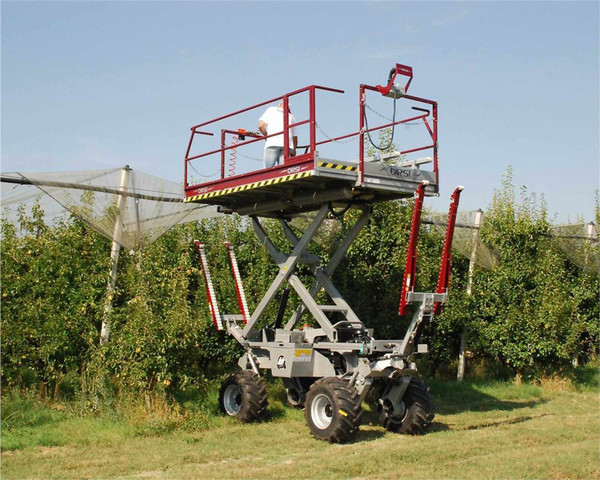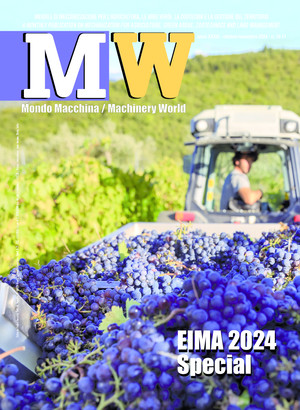
Fruit harvesting platforms, a valuable aid
Within Italian agricultural production, fruit holds a vital place. Harvesting of product from tree crops intended for consumption must be timely and careful to maintain the best-keeping characteristics of the fruit. Modern fruit harvesting platforms, especially in self-propelled versions, fully meet the requirements
Because of its temperate climate (although, unfortunately, it is changing...), the Italian peninsula is virtually in its entirety, an area particularly suited to the cultivation of fruit and vegetables.
As a matter of fact, recent surveys within the EU see Italy, along with Spain leading the list of fruit and vegetable producers.
Because of the different microclimates Italy enjoys, national fruit production is spread over a wide variety of cultivars: from apples to kiwis, peaches to citrus to exotic fruits such as mangoes and avocados.
All these crops, which are different in terms of plant morphology and planting sixth, have in common the requirement to harvest the product for fresh consumption: the typical and varied forms of plant breeding often constitute a solid limitation for fully mechanized harvesting.
The planting distances in espalier orchards are highly variable, from the thickest in the apple orchards of northern Italy (with 2.5-3 m row spacing) to the orange groves of the South, where the width can be as wide as 5 m.
Application purposes of fruit-harvesting platforms
Fruit-harvesting platforms, which have been introduced in the market for more than 60 years, are machines that facilitate the manual harvesting of the produce, not so much in the phase of detaching the fruit from the plant (robotics are being engaged in this operation), but reaching the sites in the vegetation where the product has grown, especially for rather imposing forms of farming.
Therefore, these machines simply act as facilitators in harvesting the product. They allow the operators on board to move, with a certain degree of freedom, on a platform of good extension, with adjustable height from the ground, so that they can quickly and safely reach all the fruit to be picked without having to make use of dangerous ladders, which have to be moved continuously to reach the different points of the canopy.
Newer models differ between tractor-drawn wagons and self-propelled machines.
The latter is significantly more common and equipped with an autonomous engine and adequate solutions for transmitting motion to the propulsion organs. The available engines are different in terms of type (endothermic diesel powertrain, or more recently electric, battery-powered) and power (from 20-25 to 50 Hp) to best adapt to the use scenarios.
Technical-performance characteristics
The forward speed of these machines at work in the inter-row is, of necessity, very limited (less than 1 km/h), while for transfers on inter-country and public roads, it can go up to almost 20 km/h.
The machine's structure consists of a basic frame, which houses the engine and transmission, and is equipped with pneumatic wheels (or, more rarely, rubber tracks). All self-propelled models, which vary in size to better suit the needs of different planting sites, have a relatively short wheelbase so as to keep the turning radius small and thus move nimbly in headlands.
Traction of the hydrostatic type (or most recently also electric) allows accurate progression of motion; traction can be optimized with the 4-wheel drive, which can also be all steerable.
The aerial platform, which includes the control panel and driving controls, is generally liftable up to about 3 m above the ground so that harvesting is possible even from the highest canopies.
Vertical movement of the platform is accomplished by a hydraulic cylinder (rarely more than one) acting on a pantograph mechanism.
Some models have the possibility of enlarging the surface area of the aerial platform by laterally increasing the footprint obtained by extending appendages called "balconies" or "terraces."
As such, the overall platform area can be significantly increased, with widths that can exceed even 3.5 m, benefiting operators' freedom of action even with the platform partially occupied by fruit bins.
Some models are equipped with hydraulic supports placed at the front and/or rear of the machine, which are kept in a closed vertical position during transfers and are then lowered into the field to hold the bins collected.
When the bins are full, the supports ensure that they are gently slid to the ground in preparation for their subsequent loading onto a trailer for transfer to the farm.
Some manufacturers, such as Hermes of Gargazzone (BZ) and N. Blosi of Russi (RA), offer models of fruit picking wagons equipped with adjustable conveyor belts that can be reached both from the ground and from the platform, adequately shaped for the first laying of individual fruits.
The constant movement of these hangers allows the automatic displacement of the product from the picking point to the bin.
This benefits both the operational efficiency of processing and, more importantly, the fruit's integrity.
Ancillary uses
The main functions of fruit-harvesting platforms are to facilitate harvesting and, if necessary, to convey the fruit into appropriate containers. However, these machines are frequently used for secondary, albeit equally important, purposes such as pruning and laying hail nets. On tree crops, pruning is mainly done manually, so the platforms of harvesting platforms provide a solid base, of a mobile type, for reaching the upper parts of the canopies, replacing ladders or other more or less makeshift devices.
Anti-hail nets are critical in northern Italy, where hailstorms (unfortunately increasingly common, especially in the summer) risk compromising the harvest in terms of quantity and quality and consequently jeopardizing income prospects. Their deployment, including the related support structure, can be cumbersome if the aerial part of the crop extends to considerable heights, for example, up to 3-3.5 m and more. The use of harvesting platforms as elevators significantly facilitates the installation of the tie-rods, i.e., the essential elements for the subsequent laying of nets. This is carried out at the beginning of the summer period to not excessively filter solar radiation during the flowering and fruit set phases.
The self-leveling platform models
Particularly in northern Italy, orchards are often planted on sloping terrains, such as in the valleys of Lombardy and Trentino. To optimize operations in such conditions, an increasing number of fruit picking wagons are of the self-leveling type, that is, capable of keeping the aerial platform horizontal. At the same time, the supporting structure of the machine follows the slope of the ground, both in the longitudinal and particularly in the transverse direction. In this way, workers can move on a constantly flat surface, that is, with both hands free to pick fruit, instead of being forced to cling with one of them to the fence to keep their balance.
Slope compensation, especially in the transverse plane, can reach considerable values, as much as 45 percent (about 24°) and more.
Security related issues
Because of their structure and mode of operation, fruit harvesting platforms show several risk factors that should not be underestimated. The main one is overturning, which unfortunately is the cause of several accidents, including fatal ones. Although in the field, the forward speed usually is very low, in the transfer phase, even 15-20 km/h can be reached. Although, in absolute terms, this may not seem an exceptionally high value, considering the conformation of the machine, which is characterized by a relatively high center of mass, the stability of the whole can be precarious, especially when steering on uneven ground. Therefore, besides the driver, of course, operators are not allowed to be on board in the transfers.
CREA-IT in Treviglio (BG) carried out an accurate study aimed at ascertaining the stability characteristics of several models of fruit-harvesting platforms, including self-leveling ones, with personnel on board (assuming an individual mass of 90-95 kg) and bins filled with product.
In these configurations, the distribution of masses and consequent stability of the vehicles were measured on level ground and at different slopes, at different platform heights, and with the side appendages closed and extended. The results showed that the most critical conditions correspond to wagons with the platform at maximum height, with the side terraces open and two operators or more onboard. Lateral stability tests showed a critical static rollover angle of 15-20° depending on the vehicle analyzed. This value rises to around 25° for self-leveling carts, which are more stable on sloping terrain, so they are recommended for orchards in hilly and mountainous areas.








